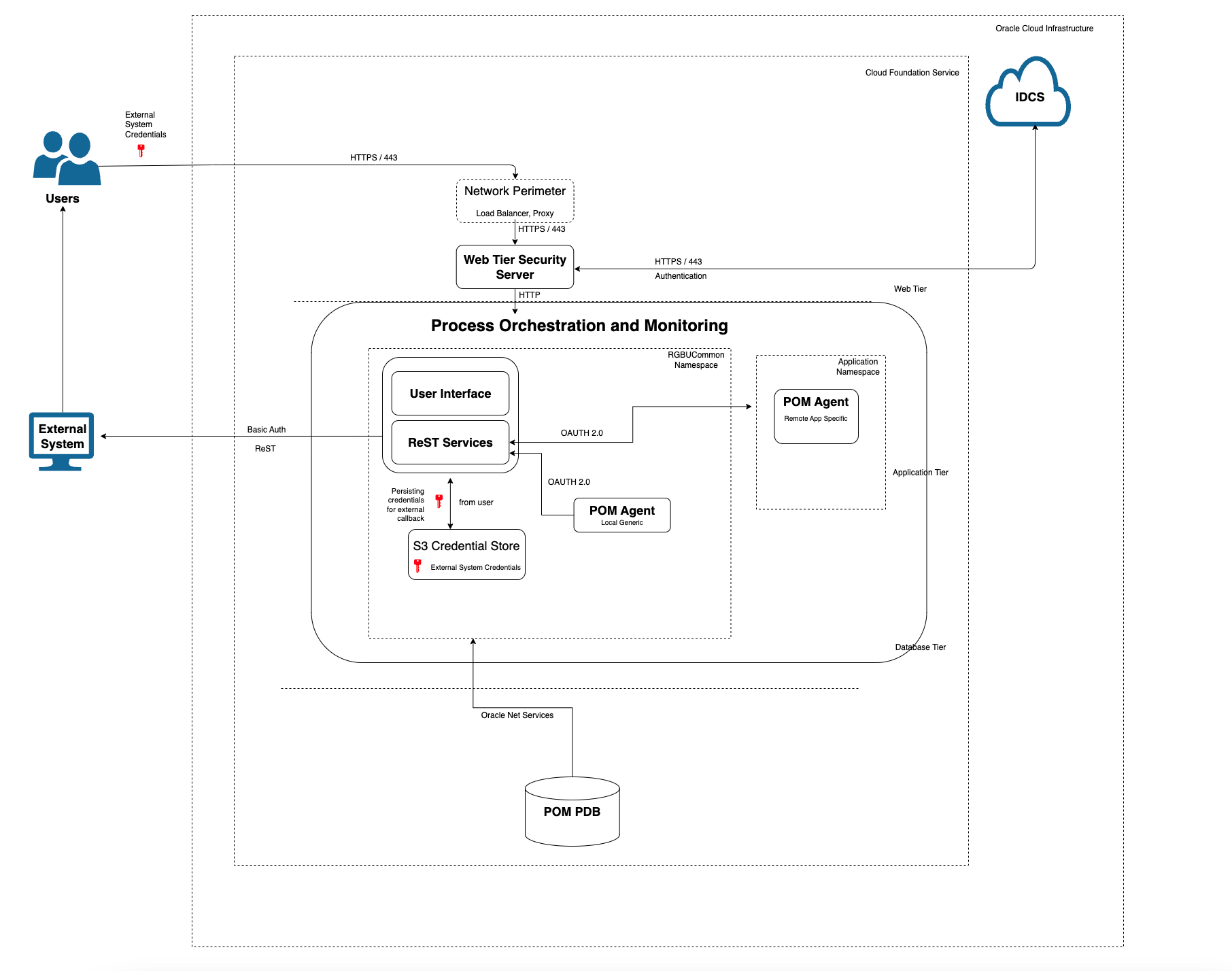4 Process Orchestration and Monitoring Cloud Service Architecture
Process Orchestration and Monitoring (POM) Cloud Service is a Java based application deployed on Oracle's Cloud Infrastructure. It is used by other retail cloud services to set up, administer, execute and monitor their batch schedules. The applications are deployed in a highly available, high performance, horizontally scalable architecture. POM Cloud Services uses either Oracle Identity Cloud Service (IDCS) or Oracle Cloud Infrastructure Identity and Access Management (OCI IAM) as its identity provider (IDP). Information about logical, physical and data architecture in this document focuses on how the architecture supports security.
Overall Architecture
This section does not explain the complete architecture of the Process Orchestration and Monitoring Cloud Service, but instead focuses on the high-level aspects that relate to security.

Most customer access to the Process Orchestration and Monitoring (POM) Cloud Service is through the web tier. The web tier contains the perimeter network services that protect the Process Orchestration and Monitoring application and associated applications from the internet at large. All traffic from the web tier continues to the Web Tier Security Server (WTSS), which in turn uses the customer's Oracle Identity Cloud Service (IDCS) or Oracle Cloud Infrastructure Identity and Access Management (OCI IAM) tenancy to perform authentication. More information about authentication through IDCS or OCI IAM is provided later in this document.
The underlying container DBaaS includes one pluggable database (PDB). Applications are able to access the POM schema on the POM PDB using Oracle Net Services aka SQL*Net. Transparent data encryption (TDE) is set during provisioning.
POM Cloud Service authenticates all internal native rest service calls using OAUTH2.0 through IDCS or OCI IAM. As a common authentication pattern is used, web service users are subject to the same strong controls as application users. All rest service calls are logged in the application logs.
Rest service calls from external systems (customers) to POM must use OAUTH2.0 (Client Credentials Grant). Refer to the POM Implementation Guide for more information about Invoking POM service using OAUTH2.0.
Note:
ReST service calls from POM to external systems (customers), such as the call for External Status Update, are limited to Basic Auth at this time.To reduce attack surface, access to the POM Cloud Service from the open internet is very limited. As described in the Architecture section of this document, Business Users (on a web browser) and also any other external web service endpoints access application over https/443.Network Perimeter blocks requests from certain blacklisted IPs as configured. Firewall and load balancer pass traffic to the WTSS server which in turn to requests authentication (through outbound proxy) from the customer's Identity Cloud Service (IDCS) or Oracle Cloud Infrastructure Identity and Access Management (OCI IAM) tenancy.
Actual batch job processing is managed by a component called POM Agent which is provided by the POM team to the corresponding Application teams. This component is packaged as part of the Application and communicates with POM through ReST endpoints.
The POM deployment model also provides for the provisioning of a common agent within the same namespace as the POM application in the rgbu-common CoD. This enables various applications to run their ReST-based batches on this agent without the need for deploying their own Agent. This simplifies the applications footprint and their POM adoption. As the POM Agent is capable of running ReST Jobs from multiple Schedules, the common agent makes it possible for multiple applications to use this single common agent for executing batch. Customers can create their own custom schedules and configure those to use this common agent to execute their batch. See the “Custom Schedules” chapter in the Process Orchestration and Monitoring Implementation Guide for more information.
Process Orchestration and Monitoring Cloud Service provides an External Status Update feature (aka callback) which sends a batch job's status to the customer's system. Additionally, POM provides a facility for the customer to create or modify the corresponding URL and credentials which POM then stores in the S3 store.
Similarly, With the introduction of Custom Job Types, POM provides an option to store the related URL(s) required to run the ReST Based Job along with the OAUTH credentials (stored in the S3 store) to access those URLs.
Readers should refer to the following links for additional information about Oracle Cloud delivery and IDCS or OCI IAM.
https://www.oracle.com/assets/ocloud-hosting-delivery-policies-3089853.pdf